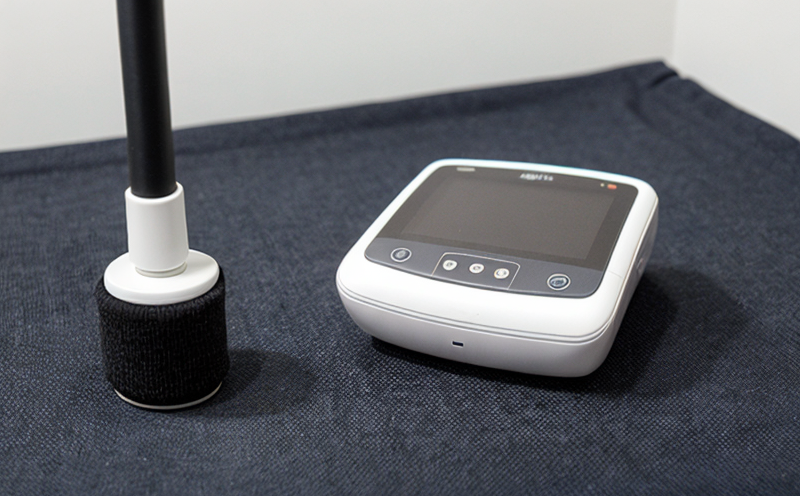Durability evaluation of solar cell embedded fabrics
The durability evaluation of solar cell embedded fabrics is a critical service that ensures long-term performance and reliability in photovoltaic applications. As sustainability and efficiency become paramount, the integration of solar cells into textiles opens up new possibilities for wearable energy harvesting systems. This service addresses the need to evaluate the structural integrity and functional stability of these materials under various environmental stressors.
The durability evaluation process involves a series of tests designed to simulate real-world conditions that the fabric may encounter during its lifetime. These include mechanical, thermal, and UV exposure stresses. The goal is to determine how well the solar cell embedded fabrics can withstand such challenges without compromising their ability to generate electricity efficiently.
One of the primary objectives in this evaluation is to ensure that the solar cells remain operational even after prolonged use. This includes assessing the degradation rates of the photovoltaic components, checking for any signs of delamination or separation between the textile base and the embedded solar cells, and monitoring changes in electrical performance over time.
For quality managers and compliance officers, this service provides a structured approach to ensure that products meet stringent international standards. For R&D engineers, it offers insights into material behavior under extreme conditions, which can inform design improvements. Procurement teams benefit from data supporting the selection of high-quality suppliers and materials.
The evaluation process typically begins with detailed specimen preparation, ensuring uniformity across samples. This is followed by a series of tests using specialized equipment designed to replicate environmental conditions such as humidity, temperature fluctuations, and UV radiation. The results are then analyzed against established criteria to provide a comprehensive assessment of the fabric's durability.
International standards like ISO 20348:2017 (Textiles — Determination of lightfastness by means of accelerated weathering) and ASTM D5297-16 (Standard Practice for Environmental Conditioning and Storage of Textile Materials) guide the testing protocols, ensuring consistency and reliability in results.
The importance of this service cannot be overstated. In sectors like renewable energy and outdoor apparel, where solar cell embedded fabrics are increasingly being used, durability is a key factor in determining product longevity and environmental impact. By investing in thorough durability evaluations, manufacturers can enhance their offerings, comply with regulations, and gain a competitive edge.
Why Choose This Test
- Precise evaluation of photovoltaic performance under real-world conditions.
- Comprehensive analysis of material integrity and function over extended periods.
- Adherence to international standards for reliability and accuracy.
- Support for product development, compliance, and quality assurance.
- Avoidance of premature failures due to environmental stressors.
- Maintenance of consistent electrical performance throughout the lifecycle.
- Enhancement of product sustainability through robust testing.
The durability evaluation service offers a unique combination of precision and reliability, making it an indispensable tool for industries reliant on solar cell embedded fabrics. By choosing this test, stakeholders can ensure that their products not only meet but exceed expectations in terms of performance and longevity.
International Acceptance and Recognition
The durability evaluation of solar cell embedded fabrics is widely recognized and accepted across various international standards bodies. This ensures that the results are comparable and valid globally, which is crucial for manufacturers aiming to export their products or operate in multiple markets.
ISO 20348:2017 provides a standardized method for determining lightfastness by means of accelerated weathering, which is particularly relevant for solar cell embedded fabrics. This standard helps in assessing how well the materials can withstand exposure to UV radiation and other environmental factors that may lead to degradation.
ASTM D5297-16 offers a framework for environmental conditioning and storage of textile materials, ensuring that the specimens used in testing are representative of real-world conditions. This standard is essential for maintaining consistency in test results across different laboratories and regions.
Recognition from these standards not only enhances credibility but also facilitates compliance with global regulations. By adhering to such recognized protocols, manufacturers can ensure their products meet international quality benchmarks, thereby expanding market reach and fostering trust among consumers.
Use Cases and Application Examples
| Use Case | Description |
|---|---|
| Outdoor Apparel | Solar cell embedded fabrics in jackets, hats, and backpacks that can generate power while being worn. |
| Roadside Billboards | Self-powered billboards that can be powered by solar energy harvested from the fabric. |
| Wearable Technology | Smartwatches and other wearable devices embedded with solar cells for extended battery life. |
| Solar Canopies | Covers for parking lots or bus stops that generate electricity using embedded fabrics. |
| Military Applications | Tents and shelters designed to provide energy while deployed in remote locations. |
| Application Example | Description |
|---|---|
| Solar Backpack | A backpack that integrates solar cells into its fabric to charge electronic devices on the go. Testing ensures it can withstand various outdoor conditions. |
| Solar Tent | A portable tent equipped with embedded solar cells, providing power for lighting and other devices during camping trips or emergency situations. |
| Self-Powered Signage | Signs that use embedded fabrics to generate electricity from sunlight, reducing the need for external power sources. |
| Solar Clothing Line | A collection of clothing items designed with solar cells integrated into their fabric, enhancing mobility and sustainability. |
The versatility of solar cell embedded fabrics makes them suitable for a wide range of applications. From outdoor apparel to military equipment, these materials offer unique advantages in terms of energy generation and environmental impact. The durability evaluation service plays a pivotal role in ensuring that these innovative products can perform reliably under diverse conditions.





